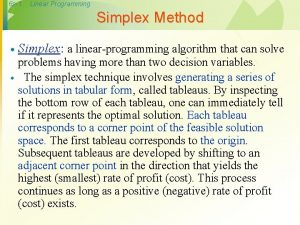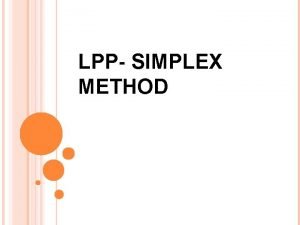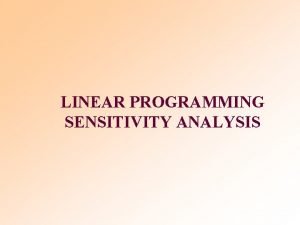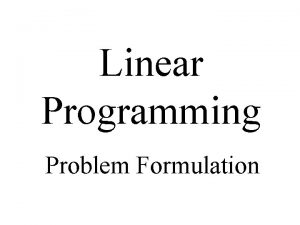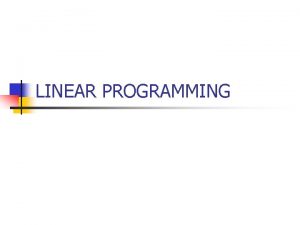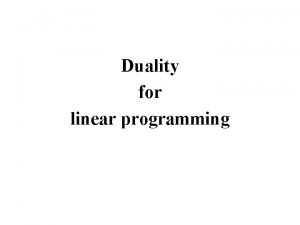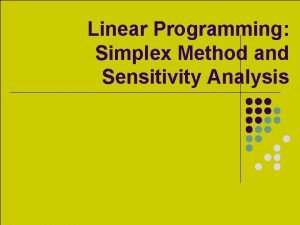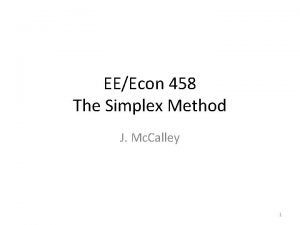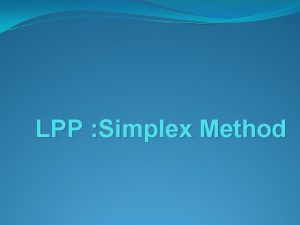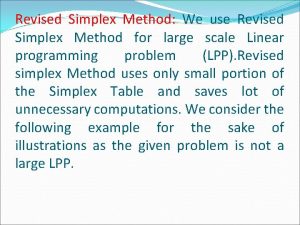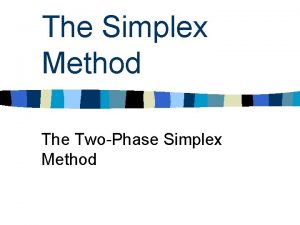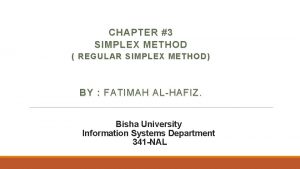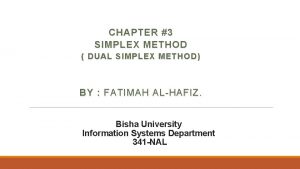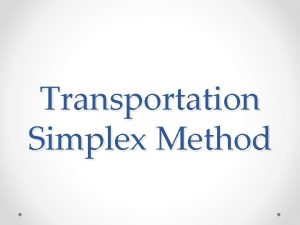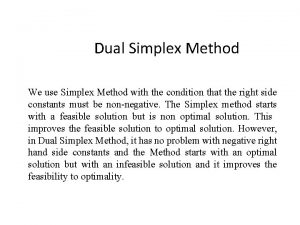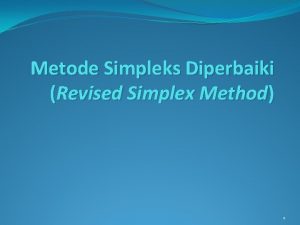LPP SIMPLEX METHOD INTRODUCTION Simplex method also called











- Slides: 11

LPP- SIMPLEX METHOD

INTRODUCTION Simplex method also called SIMPLEX TECHINQUE was developed by G. B DANTZIG, an American mathematician. It is suitable for solving LPP with a large number of variables. The method also helps the decision maker to identify the redundant, an unbound solution, multiple solution and an infeasible solution. It has the advantage of being universal i. e. any linear model for which the solution exist can be solved by it.

LIMITATIONS OF LPP 1. It is difficult to understand: The LPP involves many concepts of technical nature which are not easily understandable. 2. Its procedure of solution is long and time consuming: Solution of a problem by linear programming involves a lot of steps. As such, much time and patience are required to arrive at a proper solution to a linear programming problem

3. Its graphic method of solution has limited applications: It can not be applied to linear programming problems involving more than two basic variables in the objective function. 4. Its simplex method of computation is repetitive and arduous: The procedure of such method is very complicated, long and repetitive in nature. It may require iterations of the simplex tables for more than 3 or 4 times in which case it becomes very much boring and assiduous for the complier.

5. It gives various types of solutions: It may lead to various types of solutions, viz. , feasible solution, infeasible solution, unbound solution, multiple solution, and degenerate solution. 6. It may give absurd results: The optimal solution of an LPP may give some fractional or decimal results in relation to some variables which are very much impractical and absurd.

7. It does not allow any uncertainty or unknowns: The model of LPP assumes known values for the objective and constraint requirement. In reality the values of such factors may remain unknown. 8. It assumes linearity of the functions: This model formulates the objective function and the constraint functions of a problem in a linear order assuming that all the variables involved in the problem increase or decrease.

9. It fails to give a solution where multiple goals are involved: It give solution to the variables of a problem which involves only one objective. 10. It involves difficulties in finding out meaningful values of some factors: In real situations it is difficult to find out the meaningful values of some important factors, viz. , unit cost, capacity of the constraints, coefficients of the equations involved in a linear programming problem. Any error committed at this stage may completely offset the advantages expected from the linear programming solution.

SENSITIVITY ANALYSIS Ø Ø The optimum solution to linear programming problems are based on deterministic assumptions. This means that we assume complete certainty in the data and relationship of problem namely prices are fixes, resources known, time needed to produce a unit is set. But in real practice conditions are dynamic and changing. It may therefore be necessary to understand in what way the variation in their values will effect the optimal result. This is known as ‘Sensitivity Analysis’ of Linear Programming Model.

Ø Ø i. iii. Sensitivity analysis is useful for developing further insight into the condition of LPP. Such an analysis may consider change in three areas: Contribution rates for each variables Technological coefficients Available resources All the above changes may considered as: a. Addition or deletion of a variable b. Increase or decrease in the resources c. Changes in the cost or price

Ø So, sensitivity analysis can be used deal not only with errors in estimating input parameters to the LP model but with management experiments with possible future changes in the firm that may effect profits. There are two approaches to determine how sensitive and optimum solution is to changes: a) ‘TRIAL & ERROR APPROACH’: this usually involves resolving the entire problem each time. One input data item or parameter is changed. Ø b) ‘CURRENT OPTIMUM SOLUTION’: last table may be investigated, making use of the properties of the simplex criteria. It reduces the additional computation considerably.

LIMITATIONS OF SENSITIVITY ANALYSIS 1. Only one variable is considered at a time for the analysis. 2. Only linear relationship of changing variables is considered so it also suffers from all the limitations of linearity. 3. The extent of uncertainty is not measured in this analysis. 4. It depends upon the skill and judgment of the analyst to judge the likely changes. Thus results may vary from person to person.
